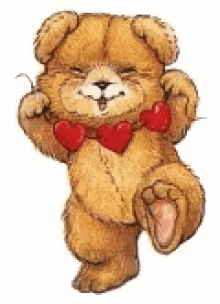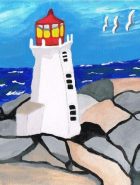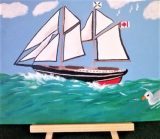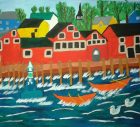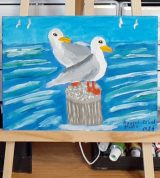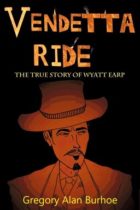Early Police Dogs…
NORTH-WEST MOUNTED POLICE DOGS: Huskies and Other Sled Dogs
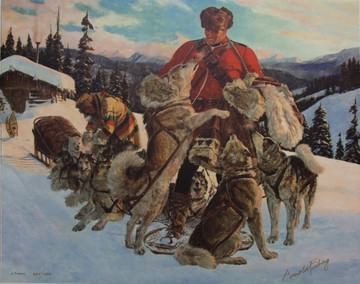
“On you huskies!” It’s our most iconic Canadian image: a lone Mountie mushing his sled dogs across the savage Northern wilderness. And not only loving it — but living it with joy.
Our Canadian Mounties were first known for their horses. They marched West in 1874 on proud Eastern stock, each Division on matched colours. Once they reached their destination, they had to purchase local remounts, many of them unbroken broncos. After 1946, they began to breed their own stock, the horses used today for ceremony and the Musical Ride.
But just as essential to the success of the Mounties, have been their dogs…
Northern Patrols and Police Dogs
When the North-West Mounted Police were first assigned to the Yukon and other northern areas, they quickly learned that they would not be patrolling by horseback.
The North Country had few land trails. Travel was more often by river and lake. In the summer, that meant boats and canoes. In the winter, when the rivers were frozen, that meant snowshoes and dog teams.
From the beginning, they adopted the native huskies and malamutes. Without the thick-coated huskies, which would curl up in the deep snow to sleep, the Mounties would never have accomplished their long winter patrols.
The Klondike Gold Rush began in August, 1896, when prospectors Skookum Jim, George Carmack and Tagish Charlie discovered a rich gold-bearing seam on Bonanza Creek in the Yukon Territory. Soon, Dawson City became a roaring boom town at the junction of the Klondike and Yukon Rivers. Thousands of prospectors, land speculators, saloon keepers, gamblers, dance hall girls, bankers and other fortune seekers arrived. The Mounties arrived with them to keep the Queen’s Law.
Their dog teams became an essential tool in keeping that law.
The first dogs that they purchased from local natives were a wild breed, truly “wolf dogs” — the natives deliberately bred their huskies with wolves.
As Constable John B Watson wrote: “Though that young team earned my respect, they kept me on my toes with their temperaments and there were a few times when they scared the hell out of me. I kept them well separated at all times and was particularly careful at feeding times to do it quickly and evenly, for then the wolf shows and etiquette disappears into thin air.
“Their daily ration disappears so rapidly one wonders how they manage to digest it. Their winter ration was half a fish. I’d break a frozen salmon in two and each piece would average two pounds. In summer when they weren’t working, I gave them boiled rice with rendered fat, and an occasional piece of dried salmon.
“Each animal wolfed its food first, and then would try to reach the next one’s ration, but their chains kept them apart. Handling each one gave me a chance to read their moods and I tried not to play favourites. I seldom had to use the whip.”
By 1898, the Force had over a hundred dogs, distributed at Dawson City, Whitehorse, Tagish, Tantalus and other small posts along the trails.
The Mounties added Siberian huskies and Labrador dogs to their teams, these breeds proving to be more easily trained and safer to be around.
By the turn of the 20th Century, patrols were extended well into the Arctic, the Land of the Midnight Sun.
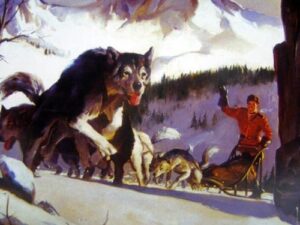
The Northern Patrols of the early years of the century were hard, often heroic journeys of hundreds of miles per trip.
Constable Charles R Thornback wrote: “One of my dogs became sick and dragged along in its harness, hampering the others of its team, and it appeared too ill to continue. It had earlier shown signs of faltering, and there was nothing we could do for it. A bullet in the head was a merciful and immediate end to its suffering. Sorrowfully, I dug a deep hole in the snow, cut a few branches of spruce for its bed and cover, and buried it.
“We were all attached to our dogs. We had worked with them for weeks, calling each by name. They displayed affection and faithfulness; they were obedient and hard working. The loss of a dog was not a small one.”
In 1905, Constable Albert Pedley made the news with his 21-day dogsled trip though the storm-ravaged Canadian winterscape — bringing an insane prisoner safely to Fort Saskatchewan. The adventure became the basis of many written stories and even a Hollywood movie: The Wild North.
In January of 1911, Inspector Francis J Fitzgerald left Fort McPherson on a patrol that was to end at Dawson City. With the Inspector were Constables Kinney and Taylor and a Sam Carter. They would go in history as the Lost Patrol.
About halfway to Dawson, they seemed to lose the trail and became lost.
They attempted to return to McPhereson. Their huskies would not eat the meat of the other dogs that had died. The Mounties fed them with what scraps of dried salmon remained.
Inspector Fitzgerald wrote in his diary: “Just after noon I broke through the ice and had to make a fire, found one foot slightly frozen. Killed another dog tonight; have only five dogs now, can only go a few miles a day…”
A second patrol later found the frozen bodies of Fitzgerald, Kinney, Taylor and Carter. The surviving huskies had fled the scene, leaving the bodies of the four men untouched. “The Lost Patrol” entered our cultural mythology.
Modern Times and Police Dogs
By the 1920’s, the North was becoming mechanized. The Bush Plane appeared. Later came vehicles that could handle the terrain, especially the snowmobile.
The need for dog teams was gone.
The Force, now renamed the Royal Canadian Mounted Police, still retained a few Northern dogs. But they were kept for sport and public events. Modern huskies, interbred with southern domesticated and racing dog breeds, are much smaller than the part-wolf dogs of yesteryear.
“On you huskies!” had become a cry of the past.
But the need for all dogs had not ended. In fact, the new Dog Service would soon be a growing department in the Force. As I wrote in my post “ROYAL CANADIAN MOUNTED POLICE DOGS: The German Shepherd”, the brave, intelligent, loyal German Shepherd had appeared. In the role of tracker of criminals, lost persons, even explosives and narcotics, the Shepherd would become an essential new member.
“Live Free, Mon Ami!” – Brian Alan Burhoe
Did You Enjoy this Mounted Police Dogs Post?
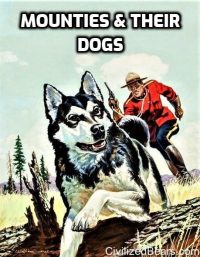 THEN YOU’VE GOT TO SEE “THE WRITERS OF THE NORTH-WEST MOUNTED POLICE” — MY MOST POPULAR LITERARY HISTORY POST:
THEN YOU’VE GOT TO SEE “THE WRITERS OF THE NORTH-WEST MOUNTED POLICE” — MY MOST POPULAR LITERARY HISTORY POST:
“Thanks for a wonderful in-depth article on Mountie fiction. I’m a big fan of the Mounties and I really enjoyed the amount of details you provided and found many, many more books to put on my wish list.” Jack Wagner
“I just discovered your blog recently and need to dig deeper into it. That post on Mountie fiction is great!” Western writer James Reasoner
An extensive study of the authors who created the magnificent Mythology of our North-West Mounted Police. My Top 10 Mountie Fiction Writers in some detail — and a look at many other novelists, short story spinners and even screenwriters. Lavishly illustrated with majestic magazine and book covers. The GREATEST AUTHORS OF NORTH-WEST MOUNTED POLICE FICTION
(See my PATRIOTIC VOICES OF CANADA: True North Songs, Poems & Stories.)
NORTH-WEST MOUNTED POLICE DOGS: Huskies and Other Sled Dogs
Dogs, German shepherds, Huskies, North-West-Mounted-Police, on you huskies, RCMP, Royal Canadian Mounted Police, police dogs, police dogs breed, police dogs matter, sled dogs, the lost patrol, watch dogs police, wolfblood, wolf dogs, wolfdogs.


